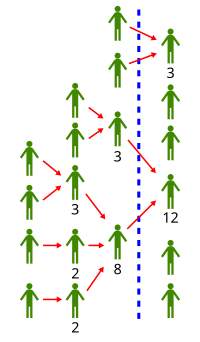User:Monkeyspaz
Transitive proxy
[edit]
Transitive proxy refers to the algorithmic process of voting where the proxy is transitive and the transfer is recursive. Put simply, the vote can be further delegated to the proxy's proxy, and so on. This applies for human voting systems or for communication systems where information is being transferred between multiple peers.
In human voting systems, transitive proxy voting is usually called delegated voting, and is also called delegable proxy, asset voting, delegate cascade,[1] or (in application) Liquid Democracy, Augmented Democracy[2], and Structural Deep Democracy. An early proposal of delegate voting was that of Lewis Carroll in 1884.[3][4] More recent proposals are by Mikael Nordfors, Bryan Ford,[5] James Green-Armytage and Michael Allan.[1]
A paper in the International Journal of Humanities and Social Sciences noted that delegated voting might be particularly useful in situations where votes are cast as the discussion is ongoing, rather than at the end of a period of discussion.[6] But Riddick's Rules seem to ban delegated voting, noting, "Proxy votes are non-transferable, containing the name of the member transferring the proxy, the person to whom the proxy is granted, and the name of the person for whom he wishes the vote to be cast or the opinion desired by the transferring member."[7]
Delegate voting is used by the Swedish local political party Demoex. Demoex won their first seat in the city council of Vallentuna, Sweden, in 2002. The first years of activity in the party have been evaluated by Mitthögskolan University in a paper by Karin Ottesen in 2003.[8] In Demoex, a voter can also vote directly, even if she has delegated her vote to a proxy; the direct vote overrules the proxy vote. It is also possible to change the proxy at any time.
In 2005, in a pilot study in Pakistan, Structural Deep Democracy, SD2[9] was used for leadership selection in a sustainable agriculture group called Contact Youth. SD2 uses PageRank for the processing of the transitive proxy votes, with the additional constraints of mandating at least two initial proxies per voter, and all voters are proxy candidates. More complex variants can be built on top of SD2, such as adding specialist proxies and direct votes for specific issues, but SD2 as the underlying umbrella system, mandates that generalist proxies should always be used.
Delegated voting is also used in the World Parliament Experiment.
References
[edit]- ^ a b Allan, Michael (2008). "A Medium of Assent and its Fit with Society" (PDF). The ITP News: Newsletter of the Information Technology and Politics Section, American Political Science Association. 4 (2): 12–13.
- ^ files.uniteddiversity.com/Decision_Making_and.../Smartocracy.pdf
- ^ Carroll, Lewis (1884). The Principles of Parliamentary Representation. London: Harrison and Sons.
- ^ Black, Duncan (1969). "Lewis Carroll and the theory of games". The American Economic Review. 59 (2): 210.
- ^ http://www.bford.info/deleg/deleg.pdf
- ^ http://www.waset.org/ijhss/v1/v1-2-19.pdf
- ^ Cite error: The named reference
RIDwas invoked but never defined (see the help page). - ^ Ottesen, Karin (2003). "Flexible representation by use of delegated voting - a case study of practical use" (PDF). Retrieved 2009-02-23.
- ^ http://groups.yahoo.com/group/sd-2/
